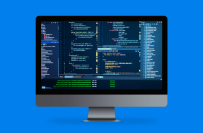
Custom Form Builder & SSO Application
$250-750 USD
Åben
Slået op 6 dage siden
•
Slutter om 13 timer
$250-750 USD
Betales ved levering
To develop a dynamic, flexible form builder application that enables users to create custom forms, configure workflows, manage submissions, and integrate with SSO (Active Directory) for user management. The system will allow roles with varying permissions to interact with forms, such as Form Admins, Managers, and other stakeholders, with notifications and dashboards to track submissions and approvals.
Core Features:
1. Form Builder with Multiple Field Types:
Field Types: The form builder should support various field types, such as text fields, drop-down menus, checkboxes, radio buttons, date pickers, file uploads, and more.
Conditional Logic: Enable dynamic field visibility based on user inputs (e.g., "if Field A is selected, show Field B").
Repeatable Fields: Allow the creation of fields that can be repeated based on user input (e.g., adding more items in a list or repeating sections of the form).
Themes: Provide pre-built themes for the form designs with the option to customize the themes. Users should be able to assign themes to forms during creation and modify them later if needed.
2. User Roles and Permissions:
- Form Admin:
Can create, edit, and manage forms.
Has access to form workflow configurations and settings.
Can view all submissions and manage form settings (e.g., updating conditions, fields, etc.).
- Manager/Lead:
Assigned to a specific form but can only view it in read-only mode.
Can view submitted data and monitor the submissions, including user participation, via an interactive dashboard.
Role should allow filtering and sorting of submissions.
- User:
Can submit the form and may interact with specific sections depending on the permissions and workflow configuration.
[login to view URL] Workflow System:
Customizable Workflows: The workflow should be easy to define and modify:
Basic submission without approval.
Level 1 approval.
Multi-level approval (e.g., Level 1, Level 2, and Level 3 approvals).
Approval Process: Forms should include an approval system where designated users (e.g., Managers, Leads) can approve or reject form submissions based on the workflow rules defined.
4. Notifications:
- Automatic Notifications: The system should send notifications to users at various stages of the form process:
* Notifications for users when their form is submitted.
* Notifications to approvers when a submission requires approval.
* Notifications to users about the approval/rejection status.
* Alerts for users and admins regarding form updates or changes.
* Notifications should be configurable based on user roles, form statuses, and workflow stages.
Customizable Notifications Per Form:
Form Admin Control: Form Admins should have the ability to customize the notifications sent for each specific form. This includes:
Message Content: The Form Admin can define the content of the notification emails, including text, form details, approval status, and other dynamic variables (such as user names, submission IDs, or approval levels).
Trigger Conditions: Define when notifications are triggered, such as after form submission, approval/rejection by a manager, or workflow updates.
Recipients: The Form Admin can specify which users or roles should receive notifications for each event (e.g., specific users, form admins, or all stakeholders).
Notification Types: Options to choose from different notification types such as email notifications, in-app notifications, or both.
Responsive Notifications Across Devices:
Mobile-Friendly Emails: All notifications (e.g., emails) must be designed to be fully responsive, ensuring they display correctly on all screen sizes, including mobile devices (Outlook Mobile, Gmail app, etc.), tablets, and desktops.
Template Customization: The Form Admin can customize the email templates to align with the form’s branding, with built-in responsive email designs that adjust automatically for different screen resolutions.
Outlook Mobile Compatibility: Specific attention should be given to ensuring email notifications are optimized for Outlook Mobile, where emails are often read on small screens. This includes proper use of layout, font size, and interactive elements like buttons or links to ensure usability on mobile devices.
5. Interactive Dashboard for Managers:
A central dashboard for managers to:
View form submissions.
View details on user participation (who has submitted, who has approved, etc.).
Filter and search submissions based on form fields, approval stages, or user attributes.
Visualize key metrics and form completion data.
6. SSO Integration (Active Directory):
Active Directory Integration: Integrate the form system with ADFS (Active Directory Federation Services) for Single Sign-On (SSO).
User Synchronization: Read all users from Active Directory and allow for user import into the system.
User Grouping: Automatically group users based on their Active Directory attributes such as department, section, or custom attributes that can be added to the form system.
7. Admin Control Over Form Access and Permissions:
Admins can define who has access to specific forms, allowing control over which roles can see, edit, or submit forms.
Ability to configure user access by form or by workflow stage.
Technical Requirements:
Backend:
A robust backend to support dynamic form creation and customizable workflows.
Integration with Active Directory for user management and SSO.
Scalable architecture to handle multiple users and forms.
Frontend:
A user-friendly, intuitive frontend interface for form creation, submission, and approval management.
Responsive design to support both desktop and mobile devices.
Drag-and-drop interface for form creation.
Security:
Data encryption for form submissions and user information.
Role-based access control for different user levels (Admin, Manager, User).
Secure API integrations for SSO and user management.
Compliance:
Ensure compliance with data privacy and security standards (e.g., GDPR) when handling user data.
Deliverables:
Form Builder Application:
Fully functional form builder interface with all required field types, conditions, and repeatable fields.
Ability to assign roles (Form Admin, Manager, User) and set permissions for each form.
Approval Workflow Engine:
A customizable approval workflow system with multi-level approval support.
Notification System:
Automated email and in-app notifications for submission status, approval requests, and updates.
Manager Dashboard:
Interactive dashboard displaying all form submissions and user participation data.
Themes Management:
A theme management system for selecting, customizing, and applying themes to forms.
SSO Integration:
Full integration with Active Directory for user authentication and role management.
Documentation:
User documentation for the form system, including how to create forms, assign roles, configure workflows, and manage submissions.
Developer documentation for setting up and maintaining the system.
Projekt-ID: 38911479
Om projektet
83 forslag
Åben for bud
Projekt på afstand
Aktiv 5 timer siden
Afgiv dit bud
$
USD
Fordele ved budafgivning på Freelancer
Fastsæt dit budget og din tidsramme
Bliv betalt for dit arbejde
Oprids dit forslag
Det er gratis at skrive sig op og byde på jobs
83 freelancere byder i gennemsnit $581 USD på dette job

4,9
(614 anmeldelser)
9,0
9,0

4,9
(466 anmeldelser)
8,7
8,7

4,8
(219 anmeldelser)
7,5
7,5

4,8
(73 anmeldelser)
7,6
7,6

5,0
(79 anmeldelser)
7,0
7,0

4,6
(96 anmeldelser)
7,7
7,7

4,6
(71 anmeldelser)
7,7
7,7

5,0
(13 anmeldelser)
7,2
7,2

5,0
(64 anmeldelser)
6,3
6,3

5,0
(24 anmeldelser)
6,4
6,4

5,0
(5 anmeldelser)
5,8
5,8

5,0
(6 anmeldelser)
5,5
5,5

4,7
(8 anmeldelser)
5,8
5,8

4,7
(14 anmeldelser)
5,7
5,7

4,5
(4 anmeldelser)
5,0
5,0

3,8
(32 anmeldelser)
5,8
5,8

3,9
(112 anmeldelser)
5,8
5,8

4,5
(31 anmeldelser)
4,9
4,9

4,7
(19 anmeldelser)
4,5
4,5

5,0
(5 anmeldelser)
4,4
4,4
Om klienten

Doha, Qatar
0,0
0
Medlem siden dec. 20, 2024
Klientverificering
Lignende jobs
$15-25 USD / time
$30-250 USD
$750-1500 USD
£10000-25000 GBP
$30-250 USD
$25-50 USD / time
₹5000-25000 INR
₹600-1500 INR
$150 USD
₹37500-75000 INR
$30-250 USD
₹600-1500 INR
$30-250 CAD
₹400-750 INR / time
₹750-1250 INR / time
$3000-5000 USD
₹12500-37500 INR
$15-25 USD / time
$15-25 USD / time
$10-30 USD
Tak! Vi har sendt dig en e-mail med et link, så du kan modtage din kredit.
Noget gik galt, da vi forsøgte at sende din mail. Prøv venligst igen.
Indlæser forhåndsvisning
Geolokalisering er tilladt.
Din session er udløbet, og du er blevet logget ud. Log venligst ind igen.





















